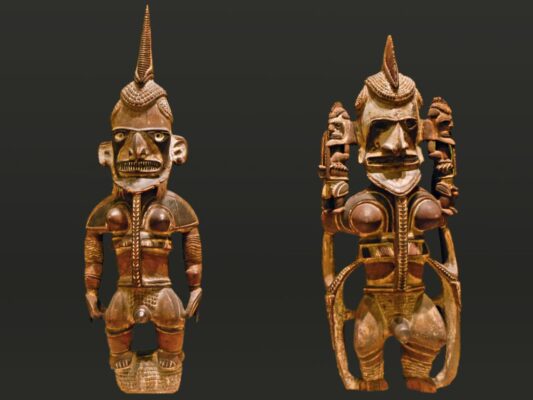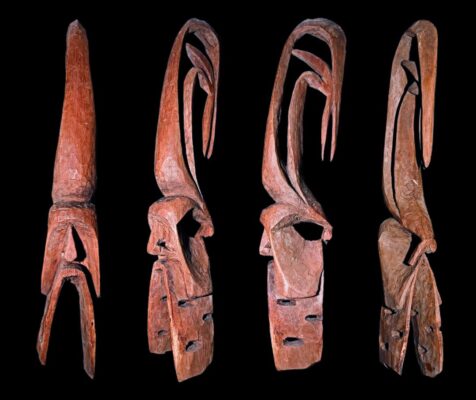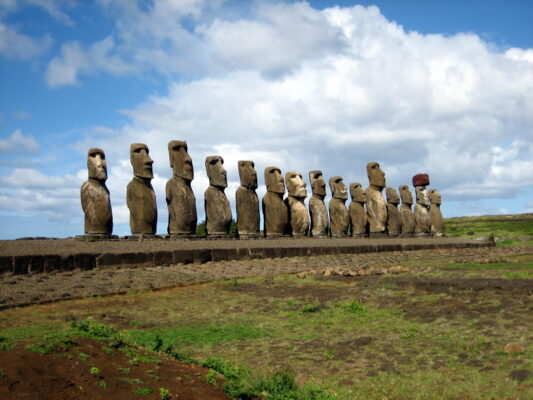Arte de Oceanía
Constelación de micromundos
¿Los habitantes de la mayor parte de Oceanía viven en espacios reducidos? La respuesta es «sí» si uno cree en lo que dicen ciertos científicos sociales. (…) Cuando ven una isla de la Polinesia o de la Micronesia, la califican naturalmente de ‘pequeña’ o ‘diminuta’. Su cálculo se basa enteramente en la extensión de las superficies terrestres que ven. Pero si observamos los mitos, las leyendas y las tradiciones orales, y las cosmologías de los pueblos de Oceanía, se hará evidente que no concebían su mundo en proporciones tan microscópicas. (…) Su mundo era todo menos ‘diminuto’».
Hau’Ofa, Epeli: «Our sea of islands», 1993

Oceania – Papua Statues Uli – photo by Dalbera

Oceania – Vanuatu canoe prow – photo by Didier Descouens

Oceania – Ahu Tongariki – photo by -Ian Sewell
Imágenes: Estatuas de Uli, Papúa. Museo Dahlem, Berlín. Foto de Dalbera ·· Proa de canoa del Pacífico – Isla Vao en Vanuatu. Foto de Didier Descouens ·· Ahu Tongariki (grupo de moai) en la Isla de Pascua. Foto de Ian Sewell.
Resulta evidente que el marco geográfico ha sido determinante en la conformación de todas las culturas del mundo, y por tanto de su arte, pero esto es especialmente claro en el caso del arte de Oceanía. El carácter insular del continente provocó que la mayor parte de los pueblos que lo habitaron vivieran prácticamente aislados del mundo exterior, dando lugar a un número enorme de culturas, generalmente de pequeño tamaño, que crearon una interesante producción artística en la que los puntos comunes son su carácter generalmente mágico/religioso y la simplificación geométrica que en ocasiones llega hasta la abstracción.
Por lo general, se suele dividir Oceanía en cuatro áreas diferenciadas, si bien los límites entre algunas de ellas varían según la fuente consultada: Australia (a la que algunos autores consideran un continente en sí misma), Melanesia, Micronesia y Polinesia. Del mismo modo que los límites geográficos entre estas zonas (excepción hecha del caso de Australia) son difusos, también lo son las diferencias artísticas entre ellas. De modo muy generalista, podemos recurrir a la clasificación realizada por el Museo de Arte Moderno de Nueva York con ocasión de la gran exposición “Arts of the South Seas” que el museo presentó en 1946, y en la que el catálogo de la exposición caracterizaba el arte de Melanesia como “exageración de las formas naturales”, el de Micronesia como “simplificación de las formas naturales” y el de Polinesia como “geometrización de las formas naturales”.
Entre el arte de los habitantes originales de Australia destaca las pinturas rupestres, que se encuentran entre las obras de arte más antiguas de la tierra. En concreto, las pinturas de la cueva de Gabarnmung han sido datadas en unos 28.000 años de antigüedad. En Melanesia, destaca la variada producción artística de Nueva Guinea (Papua), la mayor isla del continente, por detrás de Australia. La exageración de las formas naturales mencionada anteriormente es apreciable en las estatuas Uli.
Las obras más célebres de Polinesia, y quizás de todo el Arte del Pacífico, son los moai, estatuas monolíticas de la Isla de Pascua (Rapa Nui), creadas entre 1250 y 1500. El arte maorí de Nueva Zelanda es notable por su whakairo, una tradicional técnica de tallado en madera, piedra o hueso. Por su parte, el arte de las Islas Hawái destaca por sus tallas de madera y sus textiles de formas geométricas e intensos colores.
Si bien la influencia del arte de Oceanía y el Pacífico no tuvo la misma influencia sobre el arte moderno europeo que el africano, esta tampoco puede pasarse por alto. Artistas como Picasso o Matisse tuvieron obras de arte del Pacífico en sus colecciones privadas. Sin embargo, «el arte oceánico, sin embargo, tuvo quizás su impacto más profundo en los surrealistas. En la fantasiosa geografía del famoso ‘mapa surrealista del mundo’, publicado en 1929, los grandes archipiélagos del Pacífico, muy ampliados, ocupan una posición central, lo que refleja el papel crucial del arte oceánico en el movimiento.» (“Oceania: Art of the Pacific Islands in the Metropolitan Museum of Art”, publicado por el Metropolitan Museum of Art, 2007)
G. Fernández · theartwolf.com
Art of Oceania
Constellation of microworlds
«Do people in most of Oceania live in tiny confined spaces? The answer is ‘yes’ if one believes in what certain social scientist are saying. (…) When they see a Polynesian or Micronesian island, they naturally pronounce it small or tiny. Their calculation is based entirely on the extent of the land surfaces that they see. But if we look at the myths, legends and oral traditions, and the cosmologies of the peoples of Oceania, it will become evident that they did not conceive their world in such microscopic proportions. (…) Their world was anything but ‘tiny’”.
Hau’Ofa, Epeli: «Our sea of islands», 1993

Oceania – Papua Statues Uli – photo by Dalbera

Oceania – Vanuatu canoe prow – photo by Didier Descouens

Oceania – Ahu Tongariki – photo by -Ian Sewell
Images: Uli statues, Papua. Dahlem Museum, Berlin. Photo by Dalbera ·· Pacific canoe prow – Vao Island in Vanuatu. Photo by Didier Descouens ·· Ahu Tongariki (group of moai) on Easter Island. Photo by Ian Sewell.
It is clear that the geographical setting has been a determining factor in the shaping of all the world’s cultures, and therefore of their art, but this is especially clear in the case of the art of Oceania. The insular nature of the continent meant that most of the peoples who inhabited it lived practically isolated from the outside world, giving rise to an enormous number of different cultures, usually small in size, which created an interesting artistic production in which the common points are their generally magical/religious character and the geometric simplification that sometimes borderlines on abstraction.
Oceania is generally divided into four distinct areas, although the boundaries between some of them vary according to the source consulted: Australia (which some authors consider a continent in itself), Melanesia, Micronesia and Polynesia. Just as the geographical boundaries between these areas (with the exception of Australia) are blurred, so too are the artistic differences between them. In a very general way, we can draw on the classification made by the Museum of Modern Art in New York on the occasion of the major exhibition «Arts of the South Seas» presented by the museum in 1946, in which the exhibition catalogue characterised the art of Melanesia as «exaggeration of natural forms«, that of Micronesia as «simplification of natural forms» and that of Polynesia as «geometrization of natural forms«.
The art of the Indigenous Australians includes cave paintings, which rank among the world’s oldest figurative art ever found. In particular, the paintings in Gabarnmung Cave have been dated at 28,000 years old. In Melanesia, the varied artistic production of New Guinea (Papua), the largest island on the continent after Australia, is particularly noteworthy. The exaggeration of natural forms mentioned above can be seen in the Uli statues.
The most celebrated works of Polynesian art, and perhaps of all the Pacific area, are the moai, monolithic statues from Easter Island (Rapa Nui), created between 1250 and 1500. The Maori art of New Zealand is well known for its whakairo, a traditional carving technique in wood, stone or bone. The art of the Hawaiian Islands is notable for its wood carvings and textiles with geometric shapes and vivid colours.
Although the Oceanian and Pacific art did not have the same influence on modern European art as African art, it cannot be overlooked. Artists such as Picasso and Matisse had works of Pacific art in their private collections. However, “Oceanic art, however, had perhaps its most profound impact on the Surrealists. In the fanciful geography of the famous ‘Surrealist map of the world’, published in 1929, the large greatly enlarged archipelagos of the Pacific occupy a central position, reflecting the crucial role of Oceanic Art in the movement.” («Oceania: Art of the Pacific Islands in the Metropolitan Museum of Art«, published by the Metropolitan Museum of Art, 2007)
G. Fernández · theartwolf.com



